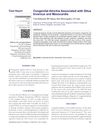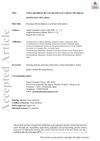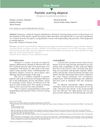TLDR Congenital atrichia with papular lesions causes permanent hair loss and skin bumps from birth.
The document discussed congenital atrichia with papular lesions (APL), a rare autosomal recessive condition characterized by irreversible hair loss shortly after birth and the development of keratin-filled cysts on the body. A case study of a 4-year-old boy with complete body hair loss and skin-colored papules was presented. The condition was linked to mutations in the hairless gene (HR) on chromosome 8p21.2, affecting hair matrix cells and preventing further hair growth. The study highlighted the complexity of diagnosing APL, noting its differentiation from other forms of alopecia and associated syndromes. Despite normal development and no systemic abnormalities, the condition remained unresponsive to therapy.
 5 citations
,
January 2012 in “International journal of trichology”
5 citations
,
January 2012 in “International journal of trichology” A 2-year-old boy had no hair and unusual organ placement, and it's unclear if it's genetic or coincidental.
 3 citations
,
March 2010 in “Dermatologica Sinica”
3 citations
,
March 2010 in “Dermatologica Sinica” A Taiwanese patient had hair loss and skin bumps without the usual gene mutation, suggesting other genetic factors might be involved.
139 citations
,
September 2001 in “The journal of investigative dermatology/Journal of investigative dermatology” Mutations in the Vitamin D receptor gene can cause hair loss similar to mutations in the Hairless gene.
 September 2020 in “Journal of Cutaneous Pathology”
September 2020 in “Journal of Cutaneous Pathology” A patient with a skin condition had unusual scarring hair loss but improved with treatment.
A 21-year-old with lichen planopilaris was successfully treated, stopping disease progression and preventing crusts.
 4 citations
,
July 2015 in “Case Reports in Dermatology”
4 citations
,
July 2015 in “Case Reports in Dermatology” A woman with unexplained hair loss was found to have harmless skin tumors and a scarring hair loss condition, but the tumors didn't cause the hair loss.
 14 citations
,
December 2013 in “Anais Brasileiros De Dermatologia”
14 citations
,
December 2013 in “Anais Brasileiros De Dermatologia” A woman with long-term scalp psoriasis developed rare scarring hair loss that didn't fully respond to treatments.




